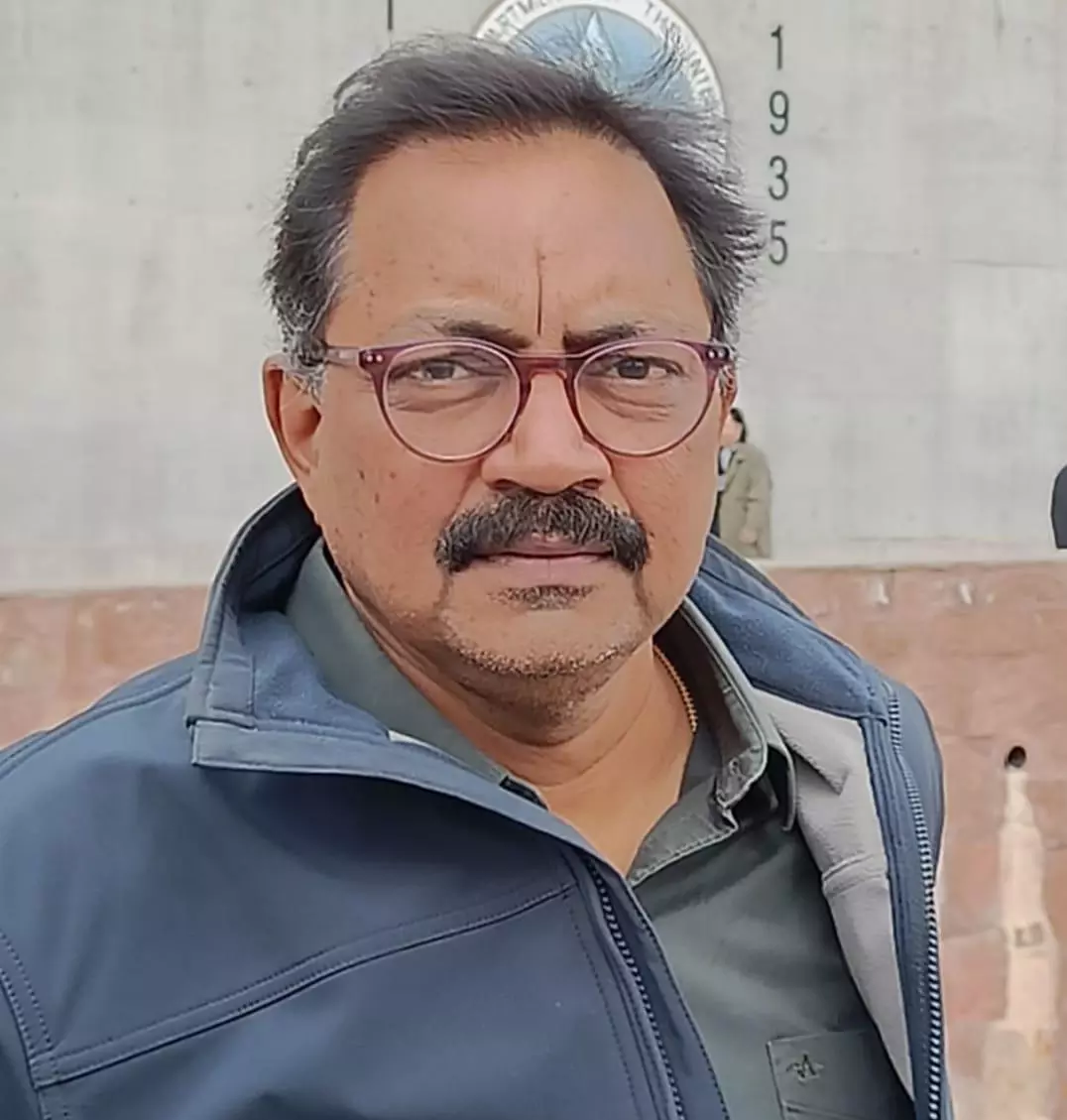Explainer on Kaleshwaram presentation: Engineers' voice muffles in political rhetoric
When the Government found out that there was nothing in it to prove that the earlier Government resorted to corruption to the tune of Rs one lakh crore, an effort was made to silence their voices, because the presentation negated the narration of the State Government.

HYDERABAD: The engineers that prepared and presented the detailed chronological presentation on the multi-stage lift irrigation scheme Kaleshwaram gave a true picture of the events that led to the sagging of a pier in the Medgadda (Lakshmi) Barrage of the project on October 21, 2023. The presentation touched on all aspects of the project since the idea was conceived and executed in record time.
When the Government found out that there was nothing in it to prove that the earlier Government resorted to corruption to the tune of Rs one lakh crore, an effort was made to silence their voices, because the presentation negated the narration of the State Government.
The engineers could have made their point clear if the presentation and the postmortem of the project were held at the Irrigation and Command Area Development (I&CAD) office in Irram Manzil in Hyderabad rather than at the Medigadda barrage site.
Could any I&CAD go against the Government and say that the project was built after receiving all approvals and not on the plan and design drawn by the former Chief Minister K Chandrashekar Rao as per his whims and fancies? They were forced to toe the line of the Government in the public meeting.
The location
The then Congress Government in the erstwhile State of Andhra Pradesh in its Detailed Project Report (DPR) of Pranahita-Chevella mentioned that the availability of water at Tummadihatti was 273.14 TMC. However, the Central Water Commission (CWC) later estimated that the availability was only 165 TMC.
After the BRS came to power in the new State, it submitted a DPR for KLIP to the CWC estimating a total availability of water from Pranahita, Wardha, Penganga, Maneru, and Godavari sub-basin at 282.3 TMC at Medigadda. The new proposal to build the KLIP at Medigadda was approved by the CWC which through its engineers estimated the availability of water at 284.3 TMC.
The BRS Government after deciding to undertake the project at Medigadda instead of Tummadihatti adhered to the Central Irrigation Project principle of a 1.5:1 ratio for revenue earned to cost incurred, meaning that a revenue of Rs 1.5 for every Rs 1 spent on the project. However, there was also an argument that the ratio should not be applied to lift irrigation projects, whose fixed costs are much higher compared to conventional projects. After much debate, the earnings for every single rupee spent on KLIP was pegged at Rs 1.55.
Issue of Maintenance
There were issues with the maintenance of the barrage and also with the Annaram and Sundilla barrages. The reason was that the barrages were not considered dams and the dam safety manual did not apply to the Medigadda, Annaram, or Sundilla barrages. The barrages came into the dam safety purview only after 2022, after the relentless pursuance of the then-BRS Government.
The National Dam Safety Authority mentioned in its report the lack of pre and post-monsoon maintenance of the Medigadda barrage. The general observation was that the water fell beyond the barrage apron directly into the sand causing seepage in Medigadda and Annaram causing the ‘piping’ effect that might have impacted the raft foundation causing the sagging in Medigadda. The NDSA and the Congress Government in unison projected that a similar kind of sagging might occur in Annaram and Sundilla rendering the entire Kaleshwaram project unfit for future use.
What the experts said
The experts who visited and conducted a detailed study of the reasons for the sagging of the piers of the Medidagga barrage did not attribute the sagging to a fault in its design. They categorically said that the sagging could be due to sand boiling or piping that happened underneath the raft foundation. The NDSA opined that a faulty design could have speeded up the sagging.
NDSA
A six-member Committee led by Member (Disaster & Resilience), National Dam Safety Authority (NDSA) visited the site on October 24, 2023, and examined the reasons for the incident. Ashwin B. Pandya, Chairman Dam Safety Review Panel & former Chairman, of Central Water Commission in their inspection report said that piers had sunk due to a combination of issues involving planning design, quality control, and operation and maintenance (O&M).
“The primary reason for the failure is the settlement of the raft which could be due to various reasons including failure of secant piles due to barrage load and construction deficiency due to lack of stringent quality control,” the report observed.
CE, Central Designs Organisation (CDO) Report
The CDO in its report stated that a hairline crack extending from the top of the pier to almost up to water level was noticed at pier numbers 19 and 21. They also found a slow whirling action of water upstream of Pier number 20. Two sand boils were noticed on the DS side of block number 7 in bays between Pier numbers 16, and 17 and between Pier numbers 17 and 18.
It was important to note that even the CDO had attributed the sagging to the problem of settlement appears not due to any structural failures and the differential settlement that led to visible cracks in the pier may be due to sand undermining below the raft.
Quality of pumps
At the project site State Roads and Buildings Minister Komatireddy Venkat Reddy while blaming the earlier Government for the sagging of the Medigadda barrage also said that even the pump houses built to lift the water were of cheap quality. Even though the issue was of the barrages that were built to stop the water, the quality of the pumps that can lift water from a height of 100 metres at Medigadda to Kondapochamma Sagar located at 600 meters height was also questioned.
Following are the world-renowned companies that supplied and fixed the pumps at Kannepalli (Lakshmi), Siripuram, (Saraswathi), Goliwada (Parvathi), Nandimedaram (Nandi), Lakshmipur (Gayatri), Annapurna (Anantagiri), Ranganayak Sagar, Mallanna Sagar and two pump houses of Kondapochamma Sagar.
BHEL
BHEL commissioned five units of Kaleshwaram Lift Irrigation Scheme Package 8 (7x139 MW) to lift 89.14 cumecs (cubic metres per second) of water by 120.98 metres. BHEL’s scope in the project comprised of completion of electrical and Mechanical (E&M) works including design, manufacture, supply, and supervision of the erection and commissioning of 7 sets of Vertical Pump-Motor sets along with associated auxiliaries. The equipment has been supplied from BHEL’s manufacturing units at Bhopal, Rudrapur, Bengaluru, and Jhansi, while the supervision of erection and commissioning at the site was carried out by the company’s Power Sector Southern Region division, Chennai.
ANDRITZ (Austria)
ANDRITZ was awarded the contract with a partner who supplied the motors. ANDRITZ manufactured 27 vertical volute pumps for three pumping stations, each with an efficiency of up to 90 percent. A special feature of these pumps is that they were similar to turbines due to their impressive size, with a Francis impeller of 3.5 m, a total weight of 130 tonne up to 200 tonne per pump, and a spiral outlet diameter of 5.5 m, large enough to park a truck comfortably.
MEIL (Gayatri Pumphouse)
Gayatri Pumphouse is the largest irrigation pumping station in the world. This four-floor pump house was built below the earth's surface at 178 metres reverse surface level. It had seven machines established, each with a capacity of 139 MW, totaling 973 MW. The pump house has four surge pools that store the water for pumping. MEIL completed it in less than 42 months.
ABB (Sweden)
ABB had supplied 37 medium voltage motors of both 40MW and 43MW sizes, 15 medium voltage load commutated inverter (LCI) drive units, the excitation systems, Low voltage, and high voltage switchgear, the PLC-based SCADA and other electricals to run the pumps. ABB’s load-commutated inverter (LCI) drive solution was designed to alleviate electrical stress and inrush current in the system. ABB MV switchgear provides further protection, stability, and management in this massive operation.
Third TMC
Would the Congress Government go for the lifting of the third TMC which was allowed by the Supreme Court of India?
It was in January 2023 that the Apex court permitted the GRMB and the CWC to consider the application of Telangana for the utilization of 3rd TMC under KLIP. The court said this while dealing with the petition filed against land acquisition by Cheruku Srinivas Reddy of Dubbak.
The present Government based on the Comptroller and Auditor General of India (CAG) report might out of expanding the project to lift the third TMC. The CAG has said that the cost-to-benefit ratio of the project was 1:0.75 in contrast to the then-state Government’s claim of 1:1.5. In addition, by taking into account the escalated costs for lifting the third TMC, the ratio would come down to 1:0.52.
According to the report, the annual operational cost for irrigating an acre of land is Rs. 46,364 crore. The annual electricity costs are estimated to be Rs. 10,374 crore. Despite the negative report by CAG on the financial viability, the BRS went ahead with the work only to fully utilise its share of the Godavari water.
Way Forward
The Congress Government has the following options before it as per the NDSA report:
➢The project designs and drawings need to be examined along with the results of geotechnical and geological investigations.
➢ All piers and rafts of the barrage must be surveyed, especially in block seven and blocks 6 and 8 (adjoining blocks), immediately to see if there is any piping or settlement.
➢ Before the remedial measures can be formulated, the extent of settlement and damage to the raft needs to be ascertained by project authorities and balance input/data provided to the committee.
➢ To avoid further aggravation of the situation until it is fully rehabilitated, the following measures should be taken:
a. Hydraulic head should not be created by ponding as it may worsen piping.
b. Gantry crane should not be operated.
c. Gates in block number 7 should not be operated.
➢ After obtaining the results from the various investigations and on the opinion of the expert committee the restoration of the Block 7 of Medigadda Barrage will be taken up and the barrage will be under operation.
Hence, the water must be stopped by building a coffer dam ahead of the Medigadda barrage, pumping out the water to initiate studies at the foundation level. The Irrigation Minister would have to take a call on this to ensure sufficient water for the command area for the coming Vanakalam (Kharif) season



